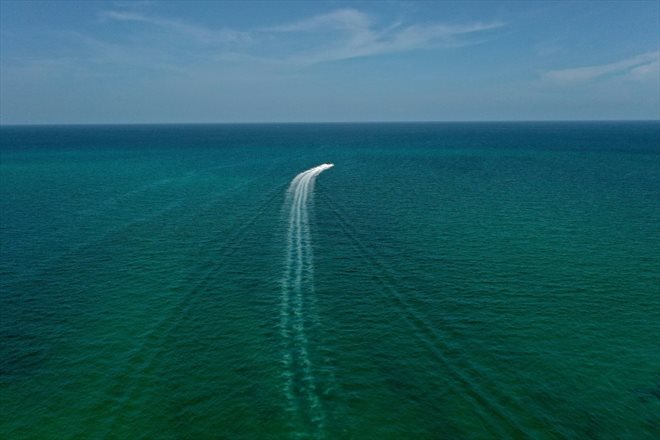A boat heads into the Atlantic Ocean on July 11, 2023 from Miami, Florida (GETTY IMAGES NORTH AMERICA/AFP/JOE RAEDLE)
Dozens of countries are expected to sign the historic high seas protection treaty on Wednesday, raising hopes of rapid entry into force to protect marine ecosystems vital to humanity.
The opening of signatures of this treaty, adopted by UN member states in June after more than 15 years of discussions, “represents an important step in enabling significant protection of the high seas”, declared to AFP Nichola Clark of the Pew Charitable Trusts.
“This is the start of a new chapter in which the international community must take bold action” to ensure that “reservoirs of marine biodiversity continue to ensure the health of the oceans and the communities around the world that depend on them “, has she.
After a final marathon negotiation in March, the text was formally adopted by consensus on June 19, even if Russia “distanced itself”.
The high seas begin where the exclusive economic zones (EEZ) of States end, at a maximum of 200 nautical miles (370 km) from the coast and are therefore not under the jurisdiction of any State.
Even though it represents almost half of the planet and more than 60% of the oceans, it has long been ignored in the environmental fight, in favor of coastal zones and a few emblematic species.
Flagship tool of the new treaty: the creation of marine protected areas in these international waters.
Today, only about 1% of the high seas are subject to conservation measures.
But in December in Montreal, all the states on the planet committed at the COP15 on biodiversity to protect, by 2030, 30% of the planet’s lands and oceans.
To achieve this, the new treaty is essential, but everything will depend on its date of entry into force, 120 days after the 60th ratification.
– “Race for ratifications” –
According to the UN, more than 60 governments have planned to initial it on Wednesday, but the ratification deadline will then vary depending on the procedures of each state.
“The race for ratifications begins and we call on countries to be ambitious, to ratify the treaty to ensure that it comes into force in 2025”, at the time of the next United Nations Ocean Conference in France, said declared Mads Christensen, interim head of Greenpeace International.
“We have less than seven years to protect 30% of the oceans, there is no time to lose.”
It remains to be seen exactly how many countries will come on board, Wednesday and thereafter.
Even if the threshold of 60 ratifications seems within reach in the near future, this figure is still far from the universality hoped for by the defenders of an ocean which knows no borders.
Science has proven the importance of protecting the entire ocean, teeming with often microscopic biodiversity which provides half of the oxygen we breathe and limits global warming by absorbing a significant part of the CO2 emitted by human activities. .
The new treaty on “the conservation and sustainable use of marine biodiversity in areas beyond national jurisdiction” also introduces the obligation to carry out environmental impact studies of planned activities on the high seas.
The text does not list these activities, which could range from fishing to ocean floor mining to maritime transport or potential controversial geoengineering activities linked to the fight against global warming.
The treaty also establishes the principle of sharing the benefits of marine genetic resources collected in the high seas, which crystallized tensions until the last minute of the negotiations. These resources are prized by pharmaceutical or cosmetic companies who hope to extract miracle molecules from them.
© 2023 AFP
Did you like this article ? Share it with your friends using the buttons below.




